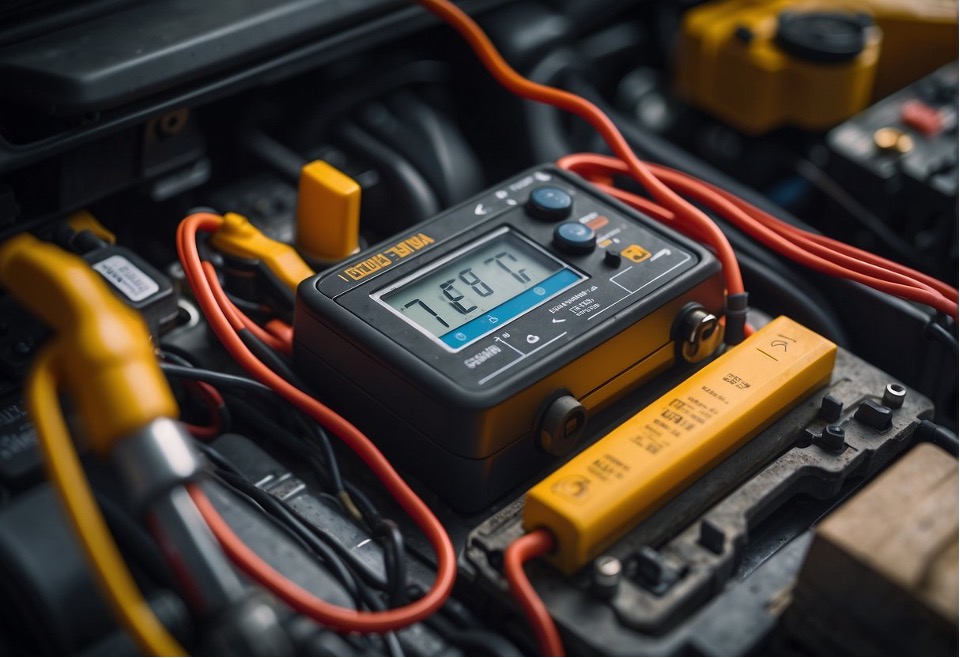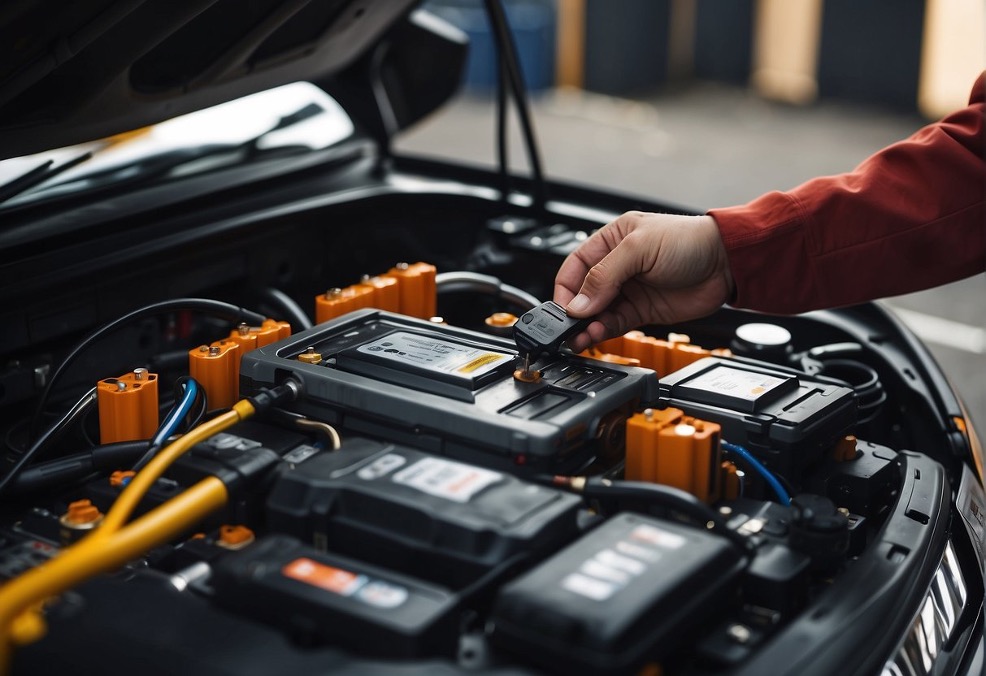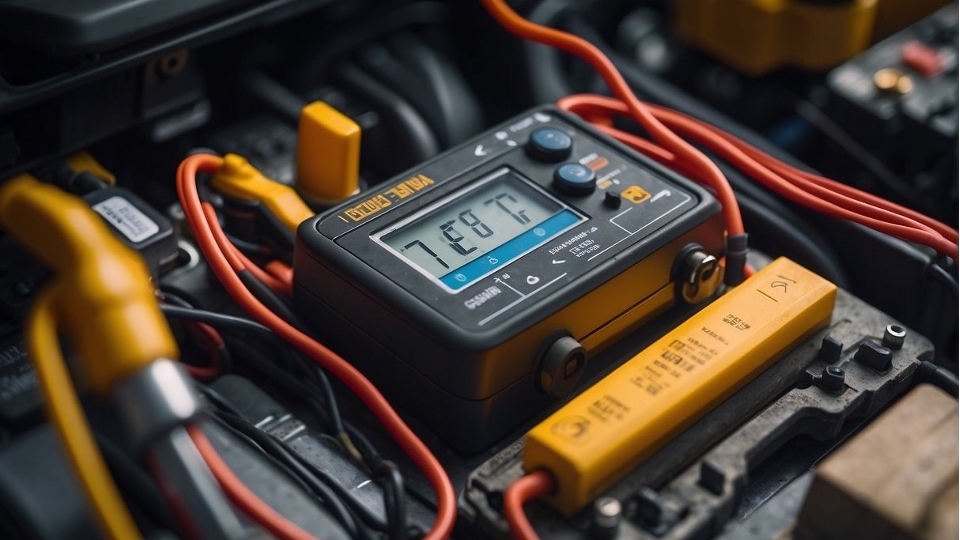Maintaining your car’s battery is critical to ensuring that your vehicle remains reliable and ready to hit the road whenever you are. Knowing how to test your car battery for signs of failure can prevent you from being stranded unexpectedly. If your car cranks slowly, your lights dim or you notice the dreaded click without the engine turning over, it’s time to check the battery.

While auto batteries have a significant lifespan, they don’t last forever. Familiarizing yourself with your vehicle’s battery specifications and understanding when to replace it is as important as knowing how to replace it properly. Should the time come for a replacement, rest assured that replacing your car battery is a manageable task that you can often accomplish with a few simple tools and safety precautions.
Key Takeaways
- Recognizing when to test and replace your car battery ensures reliability.
- Properly replacing your battery can be done with basic tools and safety steps.
- Regular maintenance extends the life of your car battery and helps avoid future problems.
Signs of Battery Failure

Knowing the telltale signs of battery failure can save you from unexpected breakdowns and ensure your vehicle is always ready to go. Let’s jump right into the indicators that suggest your auto battery might need replacing.
Difficulty Starting Engine
When you turn the ignition key, and the engine hesitates or takes longer than usual to start, your battery may be signaling its swan song. This difficulty is often due to a battery struggling to muster enough power to get the engine running – a clear warning that your battery could be on its last legs.
Dim Headlights and Electrical Issues
If your headlights are dimmer than usual, especially during startup, this is a strong indication your battery is not holding enough charge. Similarly, flickering lights or electrical components not operating at full capacity are signs that your battery may not be distributing the necessary power efficiently.
Corrosion on Battery Terminals
A visible build-up of corrosion—often appearing as a white, ashy substance—on the battery terminals is a red flag that should not be ignored. Corrosion can interfere with the battery’s ability to charge and can ultimately lead to poor electrical connections and battery failure.
Keep an eye on these symptoms, and your auto’s battery health won’t catch you by surprise!
Testing Your Battery

To ensure your car runs smoothly, testing your battery is crucial. You can do this at home with some basic tools and a bit of know-how. Let’s jump right into two effective methods for testing your auto battery’s health: using a multimeter and performing a load test.
Using a Multimeter
First, grab your multimeter. This handy device is going to tell you the exact voltage of your battery, and here’s how:
- Turn off your car: Ensure all lights and electronics are off.
- Set your multimeter: Switch the dial to the 20V setting in the DC (direct current) range.
- Connect the multimeter: Attach the red lead to your battery’s positive terminal and the black lead to the negative terminal.
Expect a reading of about 12.6 volts for a fully charged battery. If you see anything less than 12.4 volts, your battery might be undercharged. But don’t fret! It could just need a recharge.
Performing a Load Test
For the load test, you’ll mimic the strain of starting your car to see how your battery holds up:
- Keep your multimeter connected as above.
- Start your engine: Watch the voltage drop on the multimeter.
Typically, if the voltage drops below 9.6 volts while cranking but remains above 12 volts before starting, your battery is in good shape. If it drops below 9.6 volts during starting, your battery may be failing and could need replacement. This test will give you a clear idea if it’s time for a new battery or just some maintenance.
Understanding Battery Specifications

When selecting a new car battery, it’s crucial to comprehend the power required for starting your vehicle and the battery’s potential lifespan. Let’s break down these vital specs!
Cranking Amps and Cold Cranking Amps
Cranking Amps (CA): This measure tells you how much power your battery can provide at 32°F (0°C) within 30 seconds without dropping below 7.2 volts. A higher CA rating means your battery can supply more power, essential for starting your engine in most climates.
Cold Cranking Amps (CCA): CCA indicates the battery’s ability to start an engine in cold temperatures, precisely at 0°F (-18°C). The higher the CCA, the better the battery performs in cold weather. You should ensure your battery’s CCA meets or exceeds your car manufacturer’s recommendation, especially if you live in a colder climate.
Battery Age and Voltage Ratings
Battery Age: The lifespan of a battery is often referred to in years. Most batteries last between three to five years, but it’s important to check your battery’s manufacture date. A battery older than five years may require replacement, even if it seems to be working fine.
Voltage Ratings: A fully charged car battery typically has a voltage of about 12.6 volts or above. If your battery voltage drops below 12.4 volts, it’s considered undercharged, while a reading below 12.0 volts is a strong indication that your battery is significantly discharged or potentially faulty. A simple multimeter test can provide your battery’s voltage—ensuring your car starts reliably every time.
When to Replace Your Battery

You know it’s time to replace your auto battery when:
- Age: Typically, a car battery lasts about 3-5 years. If yours is hitting that age range, start to monitor it closely!
- Slow Engine Crank: When you turn the key and your auto’s engine turns over slowly, your battery might be signaling it’s time for a change.
- Warning Light: Your dashboard has a battery-shaped warning light that illuminates when your battery is in trouble. If it’s lit up, get that battery checked!
- Check the Voltage:
- Charge your battery and use a voltmeter. If it’s below 12.6 volts, considering replacing it might be your next move.
- Swelling Battery Case: Extreme temperatures can cause your battery case to swell. A swollen battery could be near the end of its lifespan.
- Weird Smell: If you notice a sulphuric, rotten egg smell when you open the hood, a leaking battery could be the culprit. Don’t wait, replace!
Pro Tip: Regularly checking your battery’s condition expands its lifespan, so keep up with those inspections!
- Visual Check:
- Corrosion: Look for any blue or white corrosion around the terminals, which is a tell-tale sign of a fading battery.
- Inspect the Terminals: Loose or damaged terminals can affect battery performance. Ensure they’re snug and clean!
Remember, a dead battery can leave you stranded at the worst times. If you’re seeing these signs, get ready to replace that battery and keep your auto running smoothly!
Choosing the Right Replacement Battery
When it’s time for a new battery, choosing the right replacement is vital for your auto’s performance. You want reliable power, a lasting investment, and a perfect fit for your car’s needs.
Matching Your Car’s Requirements
Your car’s specification is the starting point for selecting the right battery. Check your car’s manual for the correct battery group size, which corresponds to the battery’s length, width, and height. This ensures the new battery will fit your car’s battery tray and connect properly with the cables.
Next, look at the Cold Cranking Amps (CCA) rating. This rating indicates the battery’s ability to start the engine in cold temperatures. Higher CCA ratings are essential for colder climates to ensure reliable power when you turn the key.
Lastly, pay attention to the Reserve Capacity (RC) rating, which measures how long the battery can run on its own power without the engine. A higher RC is an indicator of how well the battery can handle prolonged accessory use.
Considering Battery Brands and Warranty
When you purchase a replacement, not all car batteries are created equal. It’s wise to consider reputable battery brands that are known for quality and reliability. More established brands often offer extensive warranties, which can be a sign that the company stands behind their product’s power and durability.
A warranty period typically ranges from one to five years. Longer warranties often reflect a higher-quality battery build, so look for options that offer the most extended protection period within your budget.
Here’s a quick reference to help guide your purchase:
| Battery Aspect | What to Look For |
| Group Size | Check manual for exact size to fit your auto |
| CCA Rating | Higher CCA for cold weather performance |
| RC Rating | Higher RC for longer accessory usage |
| Warranty Period | Longer warranties often indicate quality |
| Brand Reputation | Choose brands with positive reviews and presence |
By focusing on these specifics, your battery replacement will be a perfect match for your auto, offering you a smooth and uninterrupted driving experience.
Preparing for Battery Replacement
When you’re ready to replace your auto battery, the right preparation ensures a smooth and safe process! Here’s a quick guide to get you started:
- Identify the Right Battery: Make sure you’ve purchased the correct replacement battery for your vehicle. This is crucial for optimal performance.
- Gather Your Tools: Assemble the necessary tools:
- A wrench set for loosening and tightening the battery terminals.
- A wire brush to remove any corrosion present.
- Safety First: Always wear protective gloves and safety glasses. Battery acid is corrosive and can cause injury.
- Engine Off: Ensure the engine is off and the keys are removed from the ignition.
- Locate the Battery: Open your vehicle’s hood and find the battery. It’s usually near the front of the car on one side or the other.
- Inspect for Corrosion: Check the battery terminals for any signs of corrosion. This can appear as a white, blue, or greenish powdery substance.
| Step | Action |
| 1 | Visually inspect the battery and its terminals. |
| 2 | Use the wire brush to clean off any corrosion. |
| 3 | Loosen the terminal connectors with a wrench. |
Start with the negative terminal (-) before moving to the positive (+). This order is important to prevent electrical shorting and potential sparks. Once the terminals are loose, you can remove the battery clamps and proceed to take out the old battery. Get ready to install the new power source for your vehicle adventures!
Step-by-Step Battery Replacement Guide
Replacing your auto battery is a task you can accomplish with a few tools and a bit of know-how. By following these steps, you’ll ensure that your vehicle is powered up and ready to go.
Removing the Old Battery
First, ensure your car is off and the keys are removed from the ignition. Locate your battery and begin with the negative terminal. Use a wrench to loosen the nut on the negative terminal and remove the cable. Be sure to carefully handle the cables to avoid shorts. Once the negative is disconnected, move on to the positive terminal and repeat the process. With both cables off, unscrew any brackets holding the battery in place and carefully lift the old battery out.
- Tools You Need:
- Wrench set
- Protective gloves
- Eye protection
- Steps:
- Turn off the car and remove keys.
- Disconnect the negative terminal cable first.
- Disconnect the positive terminal cable.
- Remove any hold-down brackets.
- Lift out the old battery.
Installing the New Battery
Place the new battery in the car’s battery tray and secure it with the hold-down brackets. Attach the positive terminal cable first and tighten the nut to ensure a good connection. Follow by connecting the negative terminal. Ensure the connections are snug to avoid power issues. Once both terminals are connected, give them a light tug to make sure they’re secure. You’ve now successfully replaced your battery!
- Installation Checklist:
- New battery is secure in the tray.
- Attach positive terminal first, then negative terminal.
- Check connections are tight and secure.
Maintenance Tips to Extend Battery Life
Keeping your car’s battery in top condition ensures reliability and longevity. Here’s how you can proactively maintain your auto battery and love every smooth start!
- Regular Checks: Make it a habit to inspect your battery’s terminals for corrosion; a simple glance every few months does wonders. Gently clean any buildup with a mixture of baking soda and water.
- Tight Connections: Ensure your battery terminals are snugged up! Loose connections can lead to a world of electrical issues. Check and tighten them if necessary, especially before the winter season.
- Charging System Health: Be proactive with your charging system; it’s vital for battery life. Have it tested periodically by a professional to ensure it’s charging at the correct rate. Overcharging can decrease battery longevity, while undercharging can leave you stranded.
- Optimal Charge: Don’t let your battery’s charge dip too low—this can lead to sulfation. If you use your vehicle infrequently, consider a battery maintainer to keep it suitably charged.
- Heat Management: Protect your battery from excessive heat where possible; high temperatures accelerate self-discharge and can reduce lifetime. If you live in a hot climate, look into insulating blankets to shield your battery.
- Monitor in Winter: Cold weather means harder work for your battery. Keep an eye on its performance during winter months and recharge it if you notice any sluggishness when starting the vehicle.
By showing your battery a bit of love with these maintenance tips, you’re setting yourself up for a reliable and extended battery life. Get excited to hit the road, knowing you’re powered up for the long haul!
Troubleshooting Post-Installation Issues
After you’ve replaced your car’s battery, two main issues may crop up: your car might not start or there might be electrical quirks. Let’s tackle these problems with gusto!
Car Won’t Start After Battery Replacement
- Check the Connections: Ensure the battery terminals are connected properly. Tighten any loose connections and clean off corrosion with a wire brush.
- Inspect the Battery: Double-check the new battery’s health with a voltmeter. The reading should be around 12.6 volts.
If the connections are good and the battery is charged, but the car still won’t start, it’s time to consider seeking professional help. Your mechanic can diagnose deeper engine issues that may be unrelated to the battery replacement.
Electrical Problems and Solutions
- Radio Resets and Issues: Your auto’s radio may reset or lock itself as a security measure. You’ll likely need a code to unlock it, which can be found in the owner’s manual or obtained from the dealer.
- Flickering Lights: If the headlights or dashboard lights flicker, double-check the terminal connections. Ensure they’re secure and not causing intermittent contact.
For persistent or mysterious electrical problems that you can’t solve, don’t hesitate to get in touch with a mechanic. They can diagnose the issue methodically and ensure all your auto’s electrical systems are running seamlessly.
Professional Battery Services
When you’re unsure about the health of your car’s battery, don’t hesitate to seek out professional battery services! Here’s what you can expect:
- Consultation: A skilled technician evaluates your battery’s condition.
- Testing: Comprehensive diagnostic tests pinpoint any issues.
- Expertise: Certified mechanics possess a wealth of knowledge about various car models.
- Installation: Professionals ensure correct installation, securing a perfect fit for your vehicle.
- Safety: Firestone Complete Auto Care centers follow strict safety protocols to prevent accidents.
- Disposal: Old batteries are disposed of responsibly, keeping the environment in mind.
A breakdown of services often provided by professional facilities:
| Service | Description |
| Inspection | A thorough check for corrosion, leaks, and damage. |
| Voltage Test | Measures how much power your battery can deliver. |
| Load Test | Determines your battery’s ability to hold charge under use. |
| Replacement | Swap out your old battery for a new one. |
| Recycling | Eco-friendly disposal of your old battery. |
If the results suggest a new battery is due, rest assured knowing that the installation is in good hands. With pros like the team at Firestone Complete Auto Care, you’ll enjoy peace of mind knowing your car is equipped to hit the road with a reliable source of energy. Plus, they’ll take off the hassle from your shoulders!
Safety and Disposal of Old Batteries
When you’re ready to say goodbye to your dead battery, it’s vital to prioritize safety and be environmentally conscious. Batteries contain harmful chemicals, including battery acid, so proper handling is crucial.
Handling Your Old Battery:
- Wear Protective Gear: Always put on safety gloves and goggles.
- Avoid Contact with Battery Acid: If you suspect a leak, handle the battery with extreme care to prevent contact with your skin.
Disposal Guidelines:
- Recycle Responsibly: Never throw your old battery in the trash. Automotive batteries are recyclable.
- Find a Recycling Center: Use a resource like Call2Recycle.org to find a nearby drop-off location.
- Retailer Take-Back: Many auto parts stores will accept your old battery and may offer a discount on a new one as an incentive.
Environmental Impact:
- Prevent Soil Contamination: Batteries improperly disposed of can release heavy metals into the soil.
- Save Resources: Recycling batteries allows for the recovery of valuable materials.
By following these steps, you’ll ensure a safer environment for yourself and future generations while keeping the excitement of maintaining your auto alive!
